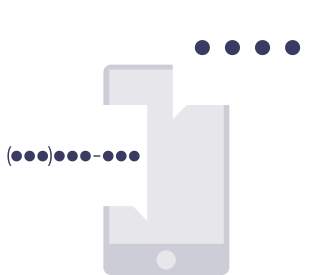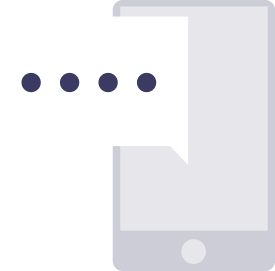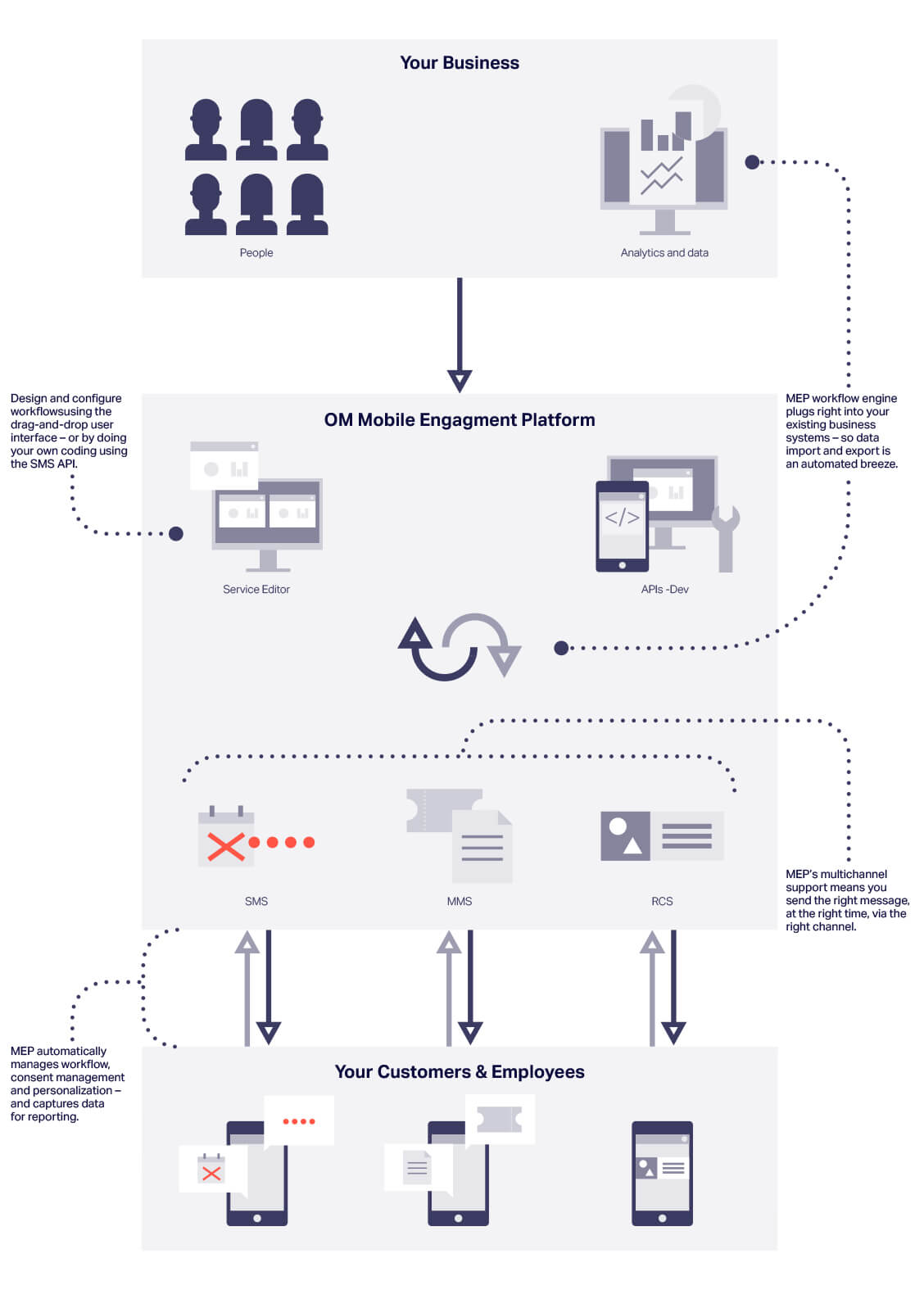Unlike one-way texting where the traffic’s all from you to your customers, a two-way system means you can get replies and automate further responses. So, instead of texting ‘Your appointment is today at 2pm’, you can say ‘Is 2pm today still good for you? Text yes or no.’ If the answer’s ‘yes’, all good. If not, you can activate a text sequence for rebooking. Easier for the customer and much more efficient for you.
What is SMS messaging?
A glossary on everything you wanted to know about SMS (but were too afraid to ask).
The SMS Glossary
#
2-way texting
Show/hide
2FA
Show/hide2FA, a nifty shorthand for ‘two-factor authentication’, means adding an extra layer of security with minimum hassle for the user. Password protection is a good first step. But with 2FA, someone logging into a work device also gets a unique code sent via SMS straight to their mobile device. To log-in, they need both their password and the code.
A
A2P
Show/hideWhen you text your friend asking, ‘Do you want to go to the cinema?’ that’s P2P SMS – person-to-person. But when your company is sending an SMS to a customer that’s A2P – application-to-person.

Activation
Show/hideOver-the-top (OTT) apps like WhatsApp were supposed to herald the death of SMS. But guess what? They can’t exist without it. These apps (and hundreds like them outside the world of text) rely on SMS for account activation. Users sign-up, and to finish the process they get a code sent to their phone via – you guessed it – SMS.

Alphanumeric Sender ID
Show/hideWant to make it easy to spot a text from your company? Then you’ll want an alphanumeric sender ID instead of a phone number. That way your customers see your name (like “Amazon”) as the message sender and immediately know who’s messaging them. One thing to note though: not all places in the world have this option—the big one being the US. Plus, your users can’t text back, so if you’re looking for a two-way conversation, you’ll need to stick to a number.

API
Show/hideAPI is short for ‘application programming interface’. An API connects different software systems – like your tech stack to our platform – over the Internet. To send a text using an API, your team programs your CRM or marketing systems to make a simple request for each message – and then you’ve got automated, speedy messaging. Your devs will be happy to hear our SMS API is RESTful (and you can send the data using either JSON and XML); and for developers who are SMS aficionados, we offer SMPP as well.
C
Chat-bot
Show/hideA chat-bot is a tool that can have a conversation via text back-and-forth with an actual person. They use keyword recognition to work out what the best reply will be based on a workflow of pre-designed responses. The more complex chat-bots also use sentiment analysis to work out the correct tone to use: so if a customer is angry, for instance, they can be apologetic.

Customer experience
Show/hideCustomer experience means the combined interactions a customer has with a brand over their entire customer journey. It takes into account environments (digital vs. real world), touchpoints (when you actually interact with them), and the journey (from pre- to post-purchase to enthusiastic brand ambassador). It’s become one of the most important differentiators between businesses. Customers expect brands to be responsive, be useful and be there to help when they need it – not when the company gets round to it.

D
Delivery receipt
Show/hideThis is a component of our system that tells us as soon as an SMS is received by a handset. It means we can give you data on how many messages were successfully delivered and which numbers don’t work so you can remove them.

E
Easy to send, even easier to ignore. Business emails just don’t cut through. They sit, unopened, unloved and forgotten, clogging up your customers’ inboxes. But when our phones go ‘ping’? We’re like Pavlov’s dogs. We just can’t ignore a text.

Empathetic Interaction
Show/hideThe Empathetic Interaction is the key to getting customer experience right. It’s about your business anticipating the needs of your customers and being there for them at precise moments in exact places. SMS is the tool that can help you create empathetic interactions. Texts are convenient and they’re usually opened straightaway. And with our tech you can be super-personal at massive scale.
Read our Empathetic Interaction eBook to find out more.

L
Long codes and short codes
Show/hideLong codes and short codes are the different kinds of numbers that can send texts. A long code looks like a regular phone number whereas a short code is usually 5 or 6 digits. Whether you use long or short codes depends on the country you’re operating in as there are different rules and regulations.

M
MMS
Show/hideMMS stands for Multimedia Messaging Service, and as the name suggests, it’s about sending texts that are packed with more than text. With MMS you can send videos, images and sound clips, as well as much longer messages, to make your messaging campaign pack an extra punch. It’s not just about marketing though – your delivery guy could use MMS to send a customer a photo of where they’ve left their package.
Mobile Engagement Platform (MEP)
Show/hideOur Mobile Engagement Platform is the space where your plans and our technology meet. Whatever you need to set up – whether it’s straightforward one-way marketing or more complex SMS workflows for two-way customer communications – the platform can do it. The drag-and-drop user interface means it’s simple to use – so you can design your programs quickly and get them up and running.

Multipart messages
Show/hideSometimes you need to send a message that’s too long to be sent in a single SMS, so instead you can send a multipart message. The message is deconstructed (by us) into separate SMS parts and then reconstructed on the mobile phone so that the end user sees just the one long message. We make sending and tracking multipart messages easy. You just send us the message the same way as normal, and we do the rest. In our reporting (and in delivery receipts), you can track what happened to each part and whether the entire message was delivered.

N
Notifications
Show/hideSMS is a perfect tool for sending employees notifications about things like IT system outages or emergency bulletins. People are busy – so emails don’t get checked, get lost in inboxes and important information gets missed. But texts go straight to your employees’ pockets – and they get read.

O
OTT
Show/hideOTT stands for ‘over-the-top’. In tech-speak, it means any app or service that disrupts traditional billing models. In the SMS world, OTT apps are things like WhatsApp, Skype and PingChat – apps where people can send messages without needing a network provider. There’s been a lot of talk about OTT apps replacing SMS messaging – but WhatsApp actually relies on SMS for user sign-up.

P
P2P
Show/hideSee A2P
Premium SMS
Show/hidePremium SMS is an SMS that sends money. For instance, when a charity runs a campaign they might use a short-code number in their advert. When a person texts that number from their phone, $10 is deducted from their mobile account and sent on to the charity.

R
RCS
Show/hideRCS stands for Rich Communication Services. RCS is next-gen messaging. It’s how the mobile industry is trying to move from the text world of SMS to a richer, more engaging kind of message that’s fit for smartphone era people. It’s the cutting edge of messaging and OpenMarket are pioneers in the field.

S
Security
Show/hideThere are all sorts of ways SMS can help make data and business processes more secure. Along with two-factor authentication (2FA), SMS can be used for password change reminders and resets, fraud alerts and compliance automation.
See how FICO uses SMS to help financial institutions improve their security.

SMS messaging
Show/hideSMS, the short version of what no one ever calls Short Message Service, is what we’re all about. Nearly 6 billion people have a mobile device that can send and receive SMS messages. Though other OTT apps are now available for text messaging, SMS is still by far the most common form of text messaging – and a massive opportunity for businesses that want to deliver the personal touch.

SMSC
Show/hideSMSC means Short Message Service Center. Think of an SMSC like a mail room. But instead of collecting then dispatching physical mail, it’s sending out SMS texts. It receives the message from the sender, figures out which network it needs to send it to, then sends the message to the intended recipient. If that person’s phone is off or has no signal, the message waits in the SMSC until the phone comes back online.

T
Two-factor authentication
Show/hideSee 2FA
U
User authentication
Show/hideSee 2FA
V
Validity period
Show/hideWhen we send a message out first time, it may not get delivered because the handset is turned off. So we’ll try again later. But for something like two-factor authentication to be secure it has to arrive more or less straightaway. Setting a validity period means you tell us something like ‘I need this message to be delivered within 10 minutes. If that doesn’t happen, don’t send it again.’
Questions and Answers
Giovanni Benini is in charge of Direct Product Management – Global SMS here at OpenMarket, and Chris Wilson is our Principal Technologist. Here, they answer a few of the most common industry questions we’re asked.
How do you manage a global SMS campaign?
How do you set up an SMS campaign?
What kind of analytics can I get from SMS messaging?
How much can two-way texting be automated?
Putting Together SMS Workflows
Q: What are the first steps in building an SMS workflow?
A: The first step is to think about what you’d like the flow of messaging to be for your end users.
Consider: Do you want to define the flow and control it? Or do you want a platform that can execute for you? Do you want to test different variables or get a basic program running first? It’s often not that obvious what members of the general public will do when you introduce SMS to certain interactions. It’s worth testing on small groups and looking at different ways that requests might be interpreted.
SMS Workflow



